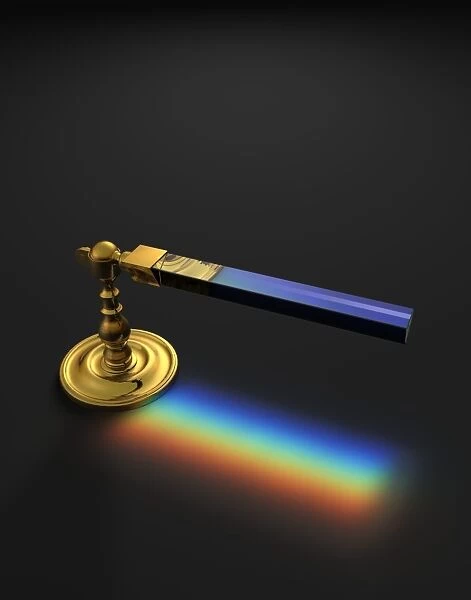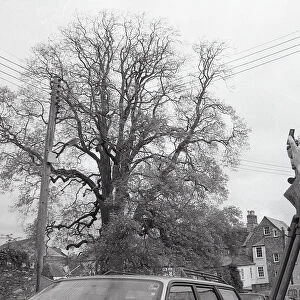19th Century Flint Glass Prism P. tif C008 / 9533
![]()

Wall Art and Photo Gifts from Science Photo Library
19th Century Flint Glass Prism P. tif C008 / 9533
Computer artwork of 19th century flint glass prism c. 1790, mounted on a rotating brass stand, of a type used to repeat experiments by Sir Isaac Newton. A narrow slit of light from the sun is focussed along the length of the prism from above, which is refracted by the prism into the colour spectrum and projected onto the surface below. In Isaac Newtons time, it was believed that white light was colourless, and that the prism itself produced the colour. Newtons experiments convinced him that all the colours already existed in the light in a heterogeneous fashion, and that " corpuscles" (particles) of light were fanned out because particles with different colours travelled with different speeds through the prism. It was only later that Young and Fresnel combined Newtons particle theory with Huygens wave theory to show that colour is the visible manifestation of lights wavelength
Science Photo Library features Science and Medical images including photos and illustrations
Media ID 6315421
© DAVID PARKER/SCIENCE PHOTO LIBRARY
Brass Colour Colourless Corpuscles Experiment Flint Focus Glass Huygens Isaac Newton Light Particles Prism Projection Theory Wave Wavelength White Light Young Fresnel Visible Spectrum
EDITORS COMMENTS
This print showcases a remarkable piece of scientific history - a 19th century flint glass prism mounted on an elegant rotating brass stand. This particular type of prism was used to replicate the groundbreaking experiments conducted by the brilliant Sir Isaac Newton. In this computer artwork, we witness a narrow beam of sunlight passing through a small slit and being directed along the length of the prism from above. As it enters the prism, the light is refracted and transformed into a mesmerizing spectrum of colors that are then projected onto the surface below. During Newton's era, there was a prevailing belief that white light had no color and that prisms were responsible for creating different hues. However, Newton's meticulous experiments shattered this notion. He discovered that all colors already existed within white light in an uneven manner. Furthermore, he proposed that particles or "corpuscles" of light dispersed because they traveled at varying speeds through the prism depending on their color. It wasn't until later when scientists Young and Fresnel combined Newton's particle theory with Huygens' wave theory that they unveiled how color truly emerges as a visible manifestation of light's wavelength. This image serves as both an homage to Sir Isaac Newton's pioneering work in understanding light and as a testament to humanity's ceaseless quest for knowledge about our world.
MADE IN AUSTRALIA
Safe Shipping with 30 Day Money Back Guarantee
FREE PERSONALISATION*
We are proud to offer a range of customisation features including Personalised Captions, Color Filters and Picture Zoom Tools
SECURE PAYMENTS
We happily accept a wide range of payment options so you can pay for the things you need in the way that is most convenient for you
* Options may vary by product and licensing agreement. Zoomed Pictures can be adjusted in the Cart.



